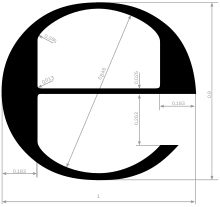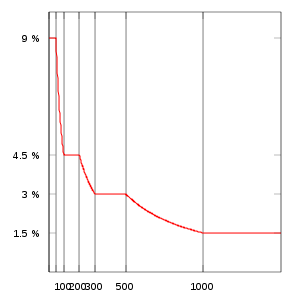- Estimated sign
-
The estimated sign (℮) (also referred to as ‘e-mark’) is a mark that sometimes can be found on prepackages in Europe. The e-mark indicates that the prepackages are filled according to the European Directive 76/211/EEC.
The scope of the Directive is limited to prepackages that have a predetermined nominal quantity between 5 g or ml and 10 kg or l, are filled without the purchaser present and of which the quantity of product cannot be altered without opening or destroying the packing material.
The e-mark indicates that:
- the average quantity of product in a batch of prepackages shall not be less than the nominal quantity stated on the label;
- the proportion of prepackages having a negative error greater than the tolerable negative error shall be sufficiently small for batches of prepackages to satisfy the requirements of the official reference test as specified in legislation;
- no prepackage having a negative error greater than twice the tolerable negative error may bear the estimated sign.
The tolerable negative error is related to the nominal quantity and varies between 9% on prepackages nominally 50 g or mL or less, to 1.5% on packages nominally 1 kg or L or more. The tolerable error decreases as nominal quantity increases, and is done by alternating intervals where there is a fixed error (and thus over the interval the percentage error decreases) with intervals where there is a percentage error.
The estimated sign looks like a lower-case "e" and its shape is precisely defined by an EU directive. It must be placed in the same field of vison as the nominal quantity. This sign has been added to the Unicode list of characters, just as the symbol for the euro has been, and can be considered a new basic character in a typeface. It is character U+212E (℮).
The e-mark may be printed on prepackages if:
- the quantity of product in the prepackages and the labelling meet the requirements, and
- the packer that fills the prepackages carries out production checks in accordance with procedures recognized by the competent departments in the Member State, and
- if he holds at the disposal of those departments the documents containing the results of such checks
Contents
Tolerable Negative Error
Error tolerance decreases as nominal quantity increases, by alternating intervals of a given percent error with intervals of a given amount error: these interpolate between the stair-step decreases in percentage error.
Thus, for instance over the interval 50–100, the tolerable error is 4.5 g or ml. At the left end of the interval, this is 4.5/50 = 9% error (as with the interval 5–50), while at the right end of the interval, this is 4.5/100 = 4.5% error (as with the interval 100–200). The factor of 2 reduction in percentage tolerable error (9% to 4.5%) corresponds to the size of the interval (50–100).
Table of tolerable negative errors Nominal quantity
in g or mlTolerable negative
error5–50 9% 50–100 4.5 g or ml 100–200 4.5% 200–300 9 g or ml 300–500 3% 500–1000 15 g or ml 1000–10000 1.5% In computer software
The "℮" symbol is listed in Unicode letterlike symbols and can be invoked in various operating systems as per the table below:
Apple Macintosh in Character Palette, search for ESTIMATED SYMBOL[1][2][3] HTML or XML ℮ or ℮[4] Microsoft Windows Alt + 212E[5] or, using the Character Map program, seach for estimated symbol. Microsoft Word U+212e or, use Insert Symbol, choose "Letterlike Symbols": the '℮' symbol is near the end of the second row. OpenOffice.org In Special Characters, in first row of Letterlike Symbols TeX \textestimated (requires the textcomp package) Unicode U+212e External links
References with typographic specifications
Use of the sign
- Council Directive of 20 January 1976 on the approximation of the laws of the Member States relating to the making-up by weight or by volume of certain prepackaged products
- Nederlands Meetinstituut [NMi]
- WELMEC Working Group 6 on e-marked prepackages [WELMEC WG6]
References
- ^ http://www.apple.com/pro/techniques/glyphspalette Apple Character Palette Instructions (English)
- ^ http://www.apple.com/de/pro/tips/specialchar.html Apple Sonderzeichen (German / Deutsch)
- ^ http://www.typografie.info/typowiki/index.php?title=Mac_Zeichenpalette
- ^ http://www.software-wahnsinn.de/tag/estimated-symbol/
- ^ http://www.fileformat.info/info/unicode/char/212e/index.htm
Categories:- Symbols
- EN standards
Wikimedia Foundation. 2010.




